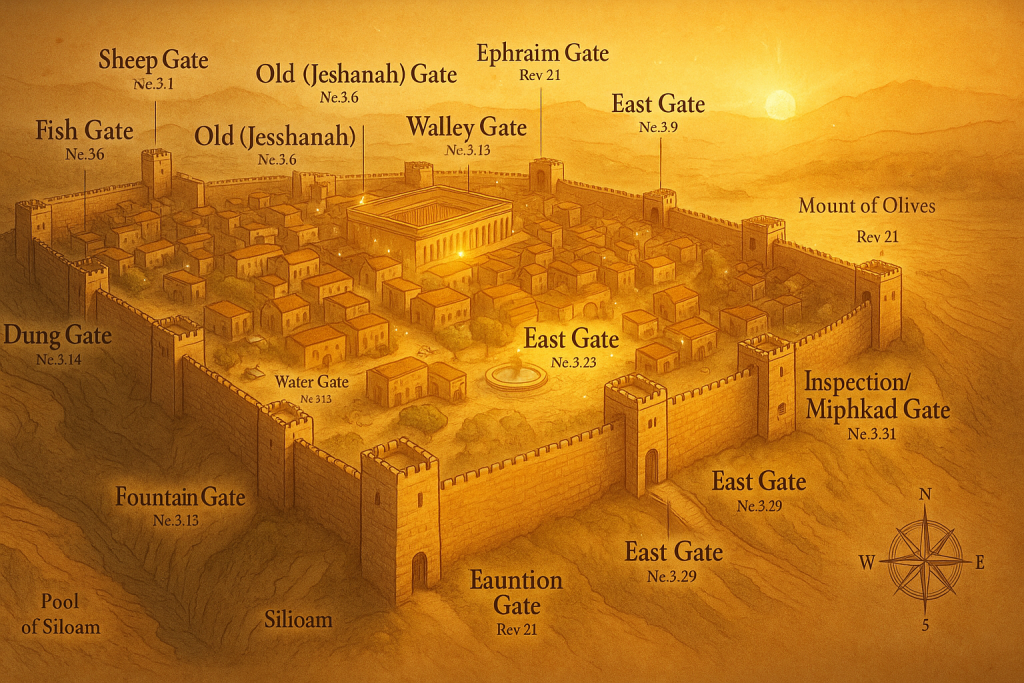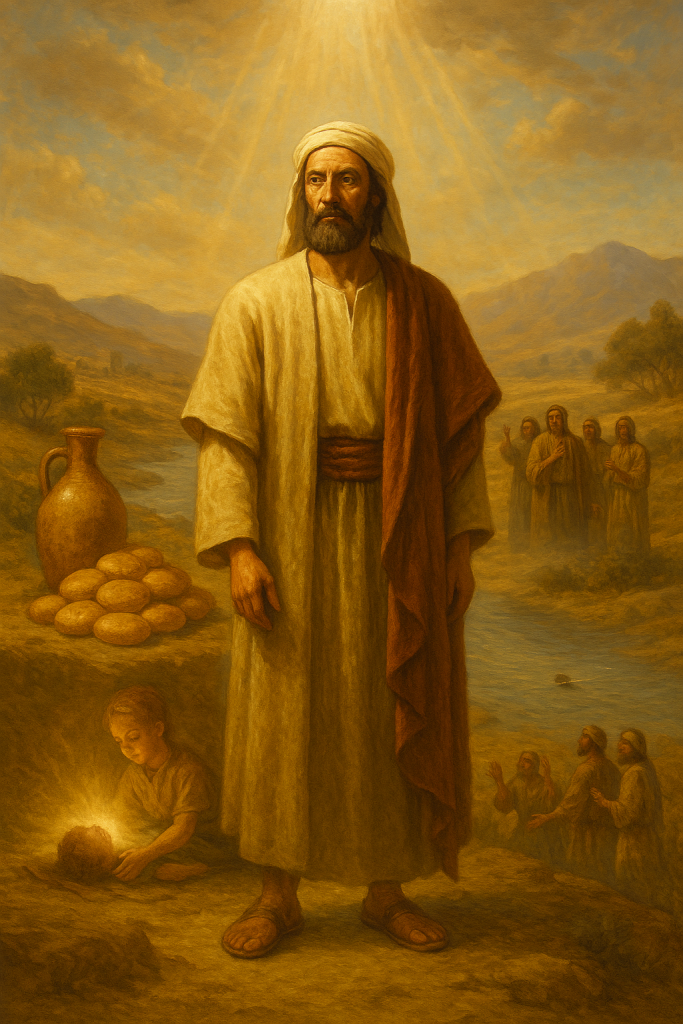This introduction sets the stage for a clear, Scripture-anchored study that readers can download and use. In brief, Nehemiah 3 records the historical rebuilding of Jerusalem’s gates after the exile, while Revelation 21 presents the New Jerusalem with twelve radiant entrances that symbolize God’s completed people. Taken together, these passages invite a careful reading of structure, symbolism, and discipleship. Therefore, this spiritual meaning of the 12 gates of Jerusalem PDF brings both worlds together: it respects the historical context of Nehemiah and, at the same time, explains how John’s vision in Revelation uses the number twelve to convey fullness and access to God’s presence.

Spiritual Meaning of The 12 Gates of Jerusalem PDF
First, you will find a concise overview of the city gates in Nehemiah who repaired them, where they stood, and why each mattered for the life of the community. Next, the guide moves to the New Jerusalem, showing how the imagery of twelve gates illuminates hope, holiness, and belonging. Moreover, to serve readers who search for 12 gates of Jerusalem and their meaning, we provide short, practical applications for prayer, Bible reading, and life in community.
Finally, use this PDF as a devotional companion or a quick historical reference. Read sequentially, or jump to the gate you most need to “repair” today; in either case, the cross-references and study prompts will keep you grounded in Scripture and moving forward in faith. For a related study that often complements this topic, see our note on discernible signs and numbers: Seeing 444 and 1111 – Biblical meaning.
12 gates of jerusalem and their meaning
Below is a quick, scannable map that readers of our spiritual meaning of the 12 gates of jerusalem pdf can use as a reference. Historically, Nehemiah 3 records ten primary gates in the restored city; devotional studies sometimes mention Ephraim and Prison (cited in Ne 8:16; 12:39) to form a set of twelve for teaching. Meanwhile, Revelation 21 presents the twelve gates of the New Jerusalem as a symbol of completeness and open access to God.
A) Nehemiah’s city gates (historical list with spiritual applications)
- Sheep Gate (Ne 3:1) — Salvation and belonging: the life of faith begins with the Lamb and a new identity in God.
- Fish Gate (Ne 3:3) — Witness and mission: from grace to outreach; faith that speaks and serves (cf. Mt 4:19).
- Old Gate (Ne 3:6) — Ancient paths, steady wisdom: returning to tested truths that shape character (cf. Jer 6:16).
- Valley Gate (Ne 3:13) — Humility and dependence: growth often happens in low places (Ps 23:4).
- Dung Gate (Ne 3:14) — Repentance and cleansing: removing what corrupts to guard holiness (1 Jn 1:9).
- Fountain Gate (Ne 3:15) — Life in the Spirit: renewal and refreshment for weary souls (Jn 7:37–39).
- Water Gate (Ne 3:26; cf. Ne 8) — Scripture’s authority: hearing, understanding, and obeying the Word.
- Horse Gate (Ne 3:28) — Vigilance in spiritual battle: courage, intercession, and perseverance (Eph 6:10–18).
- East Gate (Ne 3:29) — Hope and expectancy: orienting life toward God’s glory and future (Ez 43:1–4).
- Inspection/Miphkad Gate (Ne 3:31) — Self-examination and accountability: regular evaluation that leads to maturity (1 Cor 11:28).
- Ephraim Gate (Ne 8:16; 12:39) — Fruitfulness and outreach: God multiplies what is surrendered to Him (Jn 15:5).
- Prison Gate (Ne 12:39) — Freedom with boundaries: discipline and integrity that protect calling (Gal 5:1).
Tip: read these in order as a weekly “restoration circuit,” asking which gate in your life needs repair today.
B) Revelation’s twelve gates (theological lens)
- Named for the twelve tribes (Rev 21:12): identity and belonging God’s people fully gathered.
- Always open to God’s light (Rev 21:23–25): purity, transparency, and unbroken fellowship.
- Welcoming the nations (Rev 21:24–26): mission fulfilled creation’s glory brought to God.
- Guarded against what defiles (Rev 21:27): holiness without fear or compromise.
- Rooted in apostolic foundations (Rev 21:14): unity of Old and New Testament witness.
In short, Nehemiah’s gates guide daily discipleship and repair, whereas Revelation’s twelve gates proclaim consummation and plenitude. Read together, they offer both a path for growth now and a promise for the future.
Read also our article about:
Biblical Meaning of Dreams.
Biblical Meaning For Numbers.
Nehemiah 3: list of the gates (practical PDF guide)
This section offers a concise historical summary of the ten gates named in Nehemiah 3, along with citation tips for readers who plan to quote or teach from our spiritual meaning of the 12 gates of jerusalem pdf. Nehemiah’s chapter catalogs real repairs in a real city; therefore, we keep the focus on history first and add devotional insights only as notes. Additionally, when you later explore 12 gates of jerusalem and their meaning, remember that Nehemiah records ten in this chapter, while two other gate names appear elsewhere in the book.
The ten gates in Nehemiah 3 (history first, with brief study notes)
- Sheep Gate (Ne 3:1) Northern sector near the Temple. Rebuilt by priests, it signals worship as the city’s heartbeat.
- Fish Gate (Ne 3:3) Commercial entry on the northwest. Its activity highlights daily economics within a restored community.
- Old (Jeshanah) Gate (Ne 3:6) Western approach. The name suggests long-standing routes and civic continuity.
- Valley Gate (Ne 3:13) Southwest opening toward the Hinnom valley; strategic for access to lower terrain.
- Dung Gate (Ne 3:14) Southern outlet used for refuse; essential urban hygiene during repopulation.
- Fountain Gate (Ne 3:15) Near the Pool of Siloam; water control was critical for defense and daily life.
- Water Gate (Ne 3:26; cf. Ne 8:1–3) East/southeast zone by the Ophel. Later, public Scripture reading occurs here.
- Horse Gate (Ne 3:28) East of the Temple area; military logistics and patrol routes passed through this point.
- East Gate (Ne 3:29) Facing the Mount of Olives; a liturgical and processional orientation toward the rising sun.
- Inspection (Miphkad) Gate (Ne 3:31–32) Northeast corner; a place for mustering, assessment, and civic order.
Context note: Ephraim Gate and Prison Gate appear in Ne 8:16 and Ne 12:39, respectively. They help some teachers frame 12 gates of Jerusalem and their meaning, but the repair list of Nehemiah 3 itself contains ten.
How to study and cite the PDF responsibly
- Quote the text precisely: When citing, include book, chapter, and verse (e.g., “Ne 3:1–3”) and the Bible version used in your study.
- Distinguish history and application: State clearly when you move from historical description (Nehemiah’s city plan) to devotional use (personal “gate” repair).
- Cross-reference with maps: If you present a map in church or class, label sources and keep scale approximateBJerusalem’s topography and wall lines shifted over centuries.
- Use consistent terms: Some translations vary (e.g., “Jeshanah/Old Gate”). Keep a glossary in your notes to avoid confusion.
- Attribution in writing: When quoting from this PDF, cite the article title, URL, and access date; add page numbers if you print. This protects your readers and your credibility.
With this historical base in place, your reading of the spiritual meaning of the 12 gates of jerusalem pdf will remain grounded, while your applications can unfold naturally in the next sections.
Revelation 21: twelve gates and the symbol of fullness
Revelation 21 unveils the New Jerusalem where twelve gates frame a city radiant with God’s presence. Each gate bears the name of a tribe of Israel, while the city’s twelve foundations carry the names of the apostles. Together, tribes and apostles announce the one people of God rooted in the Old Testament and fulfilled in the New. Read in harmony with our spiritual meaning of the 12 gates of jerusalem pdf, this vision clarifies why believers talk about 12 gates of jerusalem and their meaning not as mere architecture, but as a theological portrait of wholeness.
Belonging (Rev 21:12): The tribal names on the gates affirm identity. Entry into God’s city is not random; it is covenantal. The redeemed are welcomed as family, not as strangers.
Purity (Rev 21:23–27): The city needs no sun because the Lamb is its light, and nothing unclean enters. The open gates signal free access, yet holiness remains the condition of life within God’s presence.
Communion (Rev 21:3; 21:25): “God dwells with humanity.” The gates never shut, indicating uninterrupted fellowship. Life with God is constant, not episodic—worship, work, and joy are integrated.
Consummation (Rev 21:24–26): The nations bring their glory through these gates, showing that creation’s story reaches its purpose. Mission doesn’t vanish at the end; it blossoms into worship before the throne.
Unity of Testimony (Rev 21:12–14): Twelve tribes + twelve apostles = a complete witness. The Scriptures converge: promise and fulfillment, law and gospel, Israel and the church—one household, many rooms.
Hope for today: These gates invite practical alignment. Live as those who belong; pursue purity without legalism; cultivate daily communion through Word and prayer; and serve the nations with the confidence that history is heading toward renewal. As you explore the spiritual meaning of the 12 gates of jerusalem pdf, let Revelation’s vision recalibrate your discipleship: identity received, holiness desired, community enjoyed, and purpose completed.
How to use this PDF in daily life (application & study)
This section turns the insights of our spiritual meaning of the 12 gates of jerusalem pdf into a simple, repeatable practice. Because readers often search for 12 gates of jerusalem and their meaning, the plan below blends Nehemiah’s historical gates with devotional steps you can actually take this week.
A 7-day study plan
Day 1 — Sheep Gate (Ne 3:1): Read John 1:29 and Romans 5:1. Write a brief testimony of belonging to God. Then, pray for assurance and rest in grace.
Day 2 — Water Gate (Ne 3:26; cf. Ne 8): Read Psalm 119:9–16. Choose one verse to memorize. Next, schedule two short Scripture moments for tomorrow.
Day 3 — Fountain Gate (Ne 3:15): Read John 7:37–39. Ask the Spirit to refresh one dry place in your life. Afterwards, take a 10-minute silent walk and listen.
Day 4 — Dung Gate (Ne 3:14): Read 1 John 1:9 and Psalm 139:23–24. Confess one concrete sin and take a protective step (filter, boundary, or accountability).
Day 5 — Horse Gate (Ne 3:28): Read Ephesians 6:10–18. Intercede for someone under pressure. Then, write one courage action you will take in the next 48 hours.
Day 6 — Old (Jeshanah) Gate (Ne 3:6): Read Jeremiah 6:16 and 2 Timothy 3:14–17. Re-adopt one “ancient path” you’ve neglected (Sabbath rhythm, daily prayer, charity).
Day 7 — Inspection/Miphkad Gate (Ne 3:31–32): Read 1 Corinthians 11:28 and Lamentations 3:40. Review Days 1–6, note one win and one repair, and set a next-week goal.
Optional rotation: On subsequent weeks, weave in the Fish Gate (witness), Valley Gate (humility), East Gate (hope), Ephraim Gate (fruitfulness), and Prison Gate (disciplined freedom).
Self-assessment questions for any gate
- Belonging: Where did I experience God’s welcome today, and where did I resist it?
- Purity: What needs to be carried out through my “Dung Gate” this week habit, input, or attitude?
- Scripture: What single verse is shaping my decisions? Is the Water Gate open daily?
- Prayer & Presence: When did I slow down to receive from the “Fountain”? What changed afterward?
- Mission: Who is my “Fish Gate” focus—one person I will serve or invite?
- Courage: What fear requires a Horse-Gate response intercession plus action?
- Evaluation: If I stand at the Inspection Gate, what does faithfulness look like in the next seven days?
Tips for small groups and classes
- Start with the map: Print or project the gate list. Then assign one gate per person or pair; let them read the verses and report one insight each.
- Keep it concrete: For every gate, require one practice (e.g., Scripture card, confession plan, service task) and one checkpoint (who will ask me about it?).
- Use time boxes: 10 minutes Scripture, 10 discussion, 5 application. Consequently, attention stays high and sharing stays focused.
- Close with inspection: End each meeting by standing literally or figuratively at the Miphkad Gate. Each member states one small, measurable step for the week.
- Track progress: Create a simple table with gates across the top and weeks down the side. Celebrate small wins and gently revisit stuck gates.
Lastly, keep this PDF handy as your pocket guide. Read sequentially when you have margin; otherwise, jump straight to the gate that matches today’s need.
Frequently Asked Questions (FAQ)
Nehemiah 3 catalogs ten gates being repaired in the historical city. However, some teachers include Ephraim Gate (Ne 8:16) and Prison Gate (Ne 12:39) to frame a didactic set of twelve. Consequently, guides that discuss 12 gates of Jerusalem and their meaning are using a teaching tool, not changing the original list of Nehemiah 3.
Both—just not in the same way. In Nehemiah, the gates are literal parts of Jerusalem’s fortifications with civic and liturgical roles. In Revelation 21, the twelve gates of the New Jerusalem function as symbolic theology: fullness, access, holiness, and the unity of God’s people.
When quoting or teaching from the spiritual meaning of the 12 gates of jerusalem pdf, include: article title, site name (Biblical Meaning), URL, access date, and page numbers if you print the file. Also, cite Scripture with book chapter verse and the Bible version you used.
Miphkad relates to inspection/mustering (Ne 3:31–32). Devotionally, it points to self-examination and accountability a regular check-in on growth and integrity.
The East Gate faces sunrise and, in later traditions, carries connotations of hope and expectation of God’s glory. Many readers use it as a reminder to begin the day oriented toward worship and future hope.
The Water Gate is closely associated with public reading of Scripture (Ne 8), emphasizing God’s Word. The Fountain Gate highlights refreshing and renewal, which many readers connect with life in the Spirit (Jn 7:37–39).
Yes. Read one gate per session, assign cross-references, and finish with a concrete practice (e.g., confession for Dung Gate, intercession for Horse Gate). Then, at the Miphkad Gate, each person names one measurable next step.
Nehemiah’s order follows the wall; your discipleship plan can start where your need is greatest. Nevertheless, many begin with Sheep Gate (identity in Christ) and end at Miphkad (evaluation).
Revelation’s twelve gates proclaim belonging, purity, communion, and consummation. Therefore, let the end shape the present: practice holiness, pursue fellowship, and serve your city with the confidence that God’s story is moving toward renewal.


